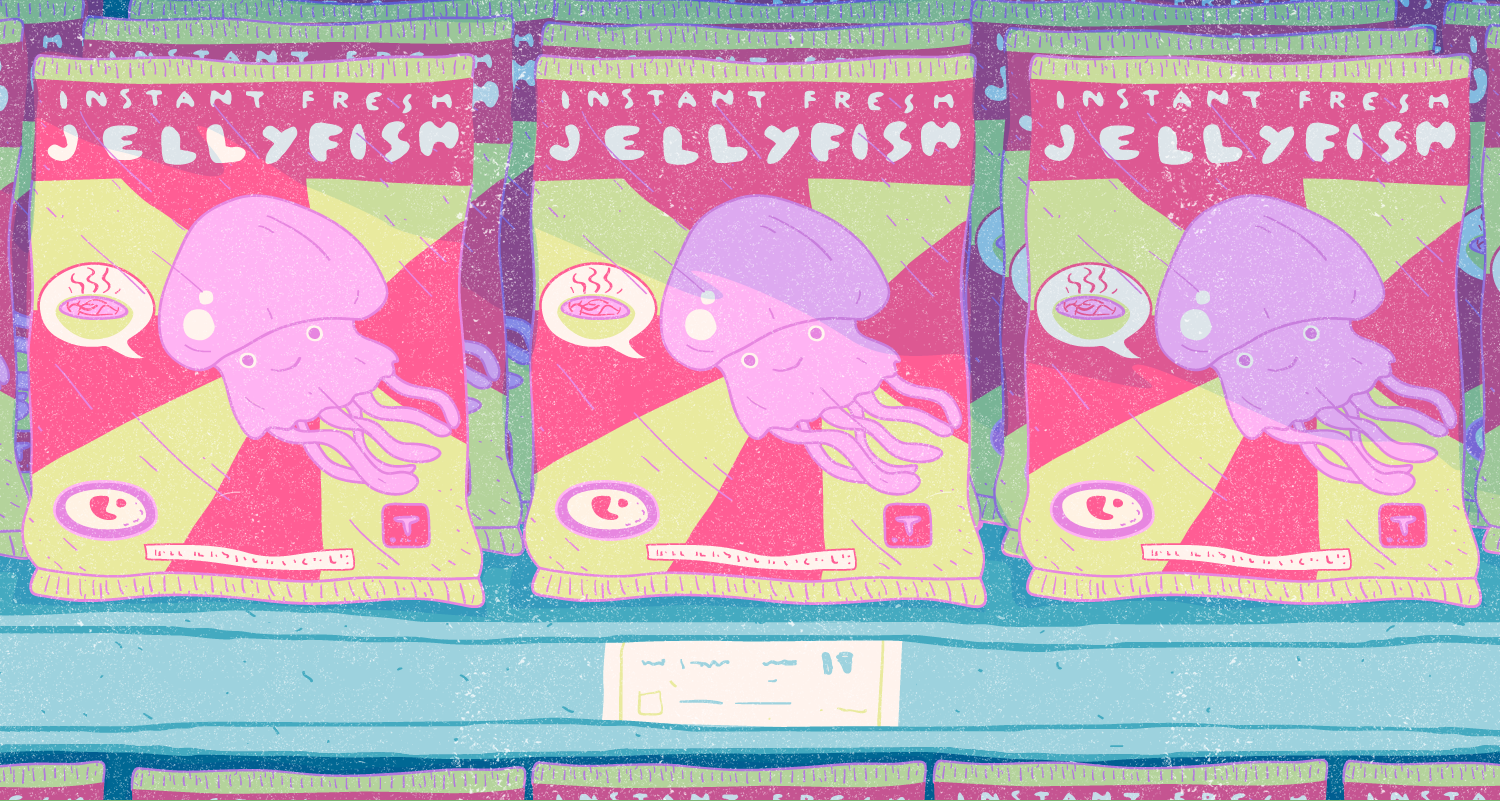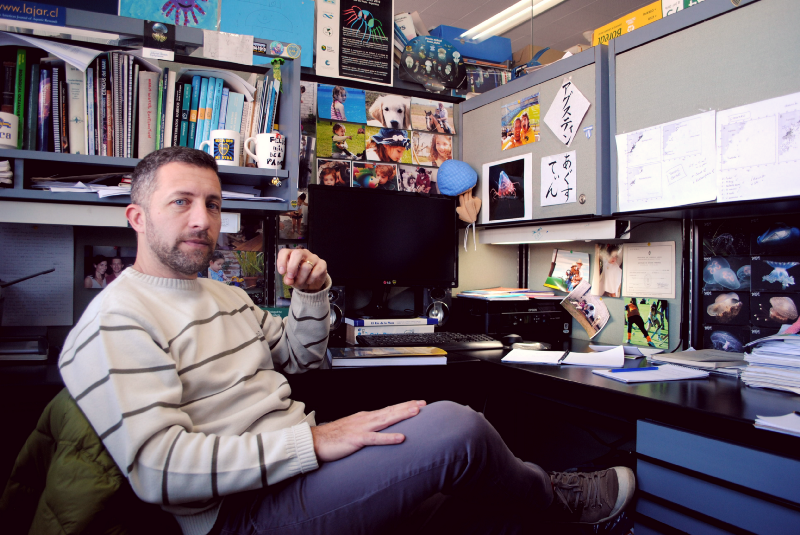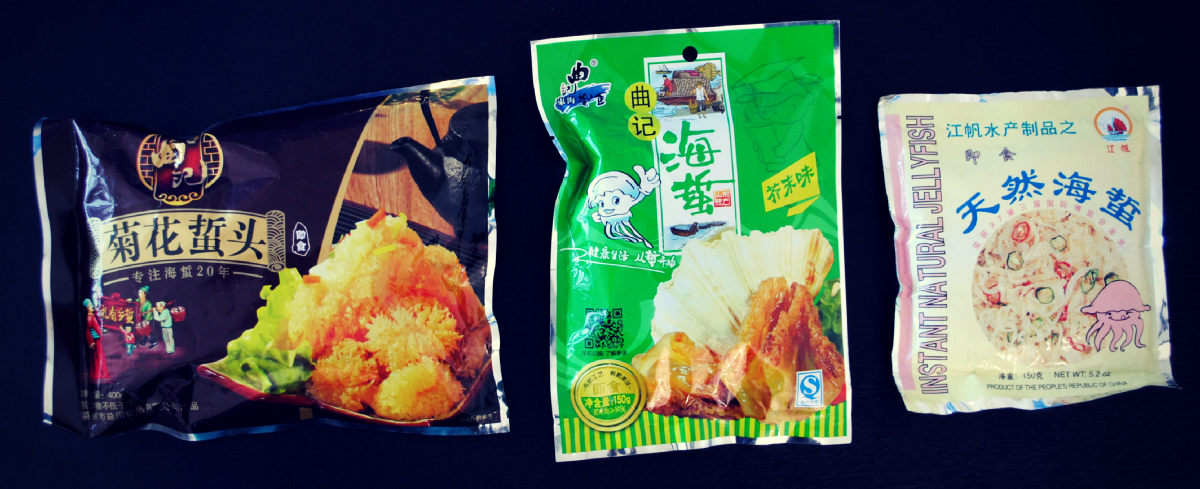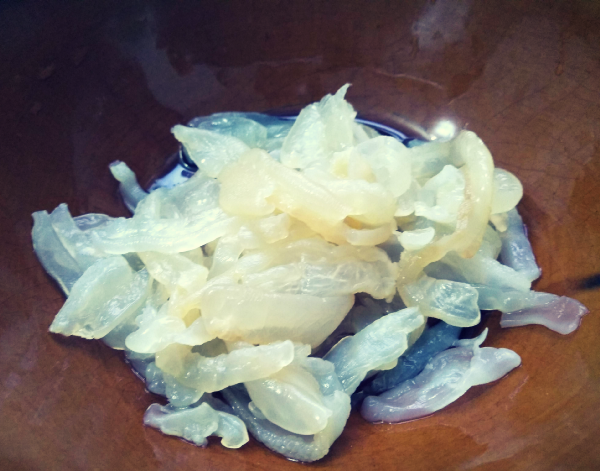

Este artículo fue escrito originalmente en Español.
Tucked between the dunes in southwestern Buenos Aires Province, the resort town of Monte Hermoso bustles with activity. It is summer, and the sandy shores of this otherwise quiet community are crowded with vacationers. Children of all ages run around, building sandcastles, playing with an assortment of balls, and laughing their hearts out. Men and women of all body types lie on deck chairs in the sun, their skin gleaming with sunscreen or tanning lotion. Retirees take seemingly endless walks up and down the beach, chatting in pairs or small groups.
The scene wouldn’t be much different from other beach destinations around the world–say, Málaga, Rimini, or Piriápolis–if it weren’t for one particular detail: no matter how hot the weather gets, the dark blue waters are almost empty of people. Swimmers, surfers, jet-skiers, kayakers–gone. There’s a simple reason: beneath the ocean surface, swarms of phantomlike, tentacled creatures await. Ashore, the situation may be under human control, but venture a few steps into the waters and you’ll find yourself knee-deep in jellyfish territory.

Olindias sambaquiensis is a translucent, waterborne predator. Its small body typically measures 3 inches (9″”10 centimeters) in diameter, crowned by 38 tentacles capable of delivering a painful sting. It is one of the 689 different species of jellyfish that have been found living in the southwestern Atlantic; in Argentina, people use the word “aguaviva” for jellyfish, which translates literally to “living water.” Each summer, between 500 and 1,000 aguaviva sting cases are reported in Monte Hermoso alone, numbers that make this the most likely place in Argentina for a person to get attacked by jellyfish. There’s an awkward, inescapable contradiction about the whole thing: Why would anyone build a resort town in a place where bathing and water sports are made impossible by what lurks in the water?
In the case of Monte Hermoso, the answer comes down to a subtle accident of history. In a similar manner to other coastal towns and cities in southern Buenos Aires–like Mar del Plata, or Mar del Sur–the resort started out as a retreat for Argentinian society’s upper crust. During the first half of the 20th century, the visiting elites stayed in and around the Hotel de Madera, a European-style grand hotel with dancing, smoking, and billiard rooms, as well as a live orchestra, a bar, and even a cinema. Back then, sunbathing and casual dips in the ocean were not considered appropriate recreational activities; these were the kind of prudish times when the mere exposure of a knee could quickly escalate into a minor scandal. As a result, the presence of jellyfish–no matter how pervasive or dangerous–was not something to worry about. Things, however, have changed: the landowning elites have dropped Monte Hermoso in favor of more chic destinations like Punta del Este in Uruguay; a tan is no longer a symbol of low-quality manual labor but of much-valued free time; and the jellyfish roaming the waters have become, despite their translucent bodies, a very visible problem for a town whose economic well-being revolves around the beach.
Monte Hermoso is not unique. Large swarms of jellyfish–”blooms”–have increasingly clogged fishing nets, interrupted sea-based fish-farming operations, and sparked short-lived panics along beaches in places as disparate as England, Japan, and the Sea of Azov. Dozens of nuclear power plants around the world have been forced to temporarily shut down in recent years due to blooms: the large pipes that suck up seawater are also prone to sucking up groups of jellyfish. Ships are at risk as well. In 2006, the USS Ronald Reagan, a sophisticated U.S. nuclear-powered aircraft carrier, became disabled after sailing through a bloom of jellyfish; the problem has only become worse since.
Jellyfish numbers are exploding worldwide, and a number of interlinked factors are responsible. The first and foremost cause is the overfishing of their natural predators–like tuna–which also removes competition for food and for space to breed. Then there are the parts of the world where humans have dumped large quantities of nutrients, as when agricultural concerns pour waste into rivers that flow to the sea. These nutrients cause immense, short-lived algae and plankton blooms, which rapidly deplete the surrounding areas of dissolved oxygen, creating so-called “dead zones.” Most fish and other marine animals can’t survive in these areas–but jellyfish can, and they also consider plankton to be perfect food. Plus, once jellyfish have established themselves as the dominant creatures in an area like this, they tend to eat the larvae of other species before those animals can reach adulthood and re-establish the natural predator-prey relationship.
Jellyfish are also some of the few natural winners from anthropogenic climate change, since their reproduction is triggered by warmer temperature cycles in the ocean. But that’s not the only environmental factor at play. There’s also evidence that they breed more comfortably on and around artificial coastal structures, like piers and quays. For this reason, it’s unclear whether stopping, or even reversing, anthropogenic climate change would in turn solve the jellyfish bloom problem, as long as humans continue to disrupt the food chain and environment. Plus, even in a context where climate change was the central cause for jellyfish blooms, we’d be talking about a long-term solution that offers little help for the short-term problem.
There have been attempts to counteract the blooms in various places around the world. Notable examples include anti-jellyfish nets near Mediterranean beaches, steel-bladed “shredders” attached to the keels of aircraft carriers in China (to avoid another USS Ronald Reagan crisis), and the use of unmanned “killer robots” in South Korea. Still, none of these offers a comprehensive solution to the problem: anti-jellyfish nets catch everything that moves (putting other marine species at risk), and both the Chinese and South Korean efforts are more focused on the protection of strategic assets (ships, coastal power plants) than on tackling the systemic causes of the blooms.
In the meantime–and not far from Monte Hermoso–one scientist has come up with a more interesting idea: if we want to solve the jellyfish issue, we should stop seeing them as a nuisance, and start seeing them as food.

“Yes, I’m the jellyman,” Agustin Schiariti jokes as he welcomes me into his office in Argentina’s National Institute for Fisheries Research and Development.
The INIDEP headquarters (the initials are taken from the organization’s Spanish name) are in Mar del Plata, a port city that doubles as the country’s most popular summer destination, along the coast to the east of Monte Hermoso. The building, a white, clean-cut concrete structure dotted with large rectangular windows, stands upon a massive breakwater that separates the city’s submarine base from the upscale Playa Grande beach. Dozens of scientists and postdoctoral researchers work here on applied marine science projects, ranging from the monitoring the surface conditions of the Argentine Sea using satellites, to the development of pilot fishery programs for species like yellowtail amberjack and octopus. Here, within the broader Fisheries Ecology program, Schiariti leads the institute’s research on jellyfish.

His office confirms his nickname: photos of colorful specimens, oceanic maps, and notes scribbled with scientific names of species and subspecies hang from the walls. On the desk, a stuffed jellyfish plush toy sits by the computer monitor, and, above it, a few dozen books about jellyfish rest on a floating shelf.
“Coastal regions around the world have seen a lot of development in the past few decades. We’ve installed nuclear plants and factories, built resorts and tourist facilities,” Schiariti says. “Resources have been allocated to countless numbers of previously undeveloped or underdeveloped spots, and a few years later we notice that, every other summer, a massive amount of jellyfish finds its way to our new favorite beach, or to a desalination plant that was put there a decade ago.”
He doesn’t see climate change as the main cause for the increasing jellyfish population worldwide–and, while it may seem like a curse to many at the moment, it could be a blessing as well. “Blooms are becoming a problem around the world, and, in parallel, there’s a number of ways we can benefit from them. Food production appears as the most realistic, viable one,” he says.
Schiariti, who has the demeanor of a cool college professor, has been studying the life dynamics of jellyfish for the past 15 years. His experience in the field with blooms, combined with the larger global context of human population growth, has led him to advocate for jellyfish as a food source.
Jellyfish do have nutritional value. They are “basically protein, water, and salt, with little to no fat content,” he explains. “I wouldn’t call it a main course, but it works fine as a siding or add-on to other dishes.”
“I’ve eaten different kinds of jellyfish in a number of circumstances and preparations during the past few years,” Schiariti continues. “It has a strange texture, at least by my standards: soft and crunchy at the same time. Is that possible? Regarding taste, it doesn’t pack the ugly punch you would expect. It’s salty, and usually very mild-flavored, almost like eating soy sprouts. Not the most memorable thing you’ll ever try, but not bad either.”
Schiariti wants people–Argentinians, but also others across the Americas and beyond–to put themselves in the shoes of those who already eat jellyfish, in places like China, Japan, Indonesia, and Thailand.
“In the Western Hemisphere, consumers don’t think of jellyfish as food, and fishermen think of it as by-catch, at best. But it’s not like that everywhere,” he points out. “In East Asia, jellyfish has long been a part of the menu. It is consumed in soups, snacks, and salads, among other ways. Not everyone in East Asia eats jellyfish the same way, or even the same kind of jellyfish, and I would like to emphasize this aspect. The Japanese, for example, don’t consume the same species of jellyfish as the people of China. This is a light proof that jellyfish is very much capable of crossing cultural barriers and can still be regarded as a valuable food in very different places.” He does, however, cushion this by conceding that only 20 of the hundreds of known jellyfish species are considered edible across these countries, so it would only involve farming a limited number of blooms.

Regardless, Schiariti argues, the development of jellyfish fisheries could bring relief to small-scale fishers around the world by providing a source of extra income. Argentina also has the sixth-largest area of shallow continental shelf within its territorial waters of any country in the world, larger than Brazil’s and half that of the United States, and it is in these kinds of waters that most fish (and jellyfish) live. But taking advantage of this new harvest will require investment and training–and that’s where the challenge for researchers like Schiariti lies.
“Policymakers continue to address the subject with incredulity,” he admits, “but millions of people around the world do think of it as food.” If you can become a provider of that food, the economic potential could be huge.
Schiariti is engaged in a difficult mission here. The kind of private and public support a jellyfish fishery project requires can be hard to find in Argentina today. The country’s economy is in severe crisis, and the fishing industry reflects current and past mistakes: aging fleets, stagnant wages, high operating costs, and illegal fishing operations, to name just a few. In Mar del Plata alone, four fishing vessels have sunk since 2015, killing 30 people. Since the cases are still under investigation, the exact causes have not yet been established, but specialists as well as family members of those who perished point to factors like government negligence. According to the city’s Chamber of Naval Industries, the average age of the ships in its fishing fleet is 40 years, and there are repeated problems with poor standards of maintenance. If we’re talking just economic viability, any bold jellyfish fishing project would be exposed to the same systemic troubles that muddle Argentina’s commercial fishing industry as a whole.
There is also the challenge of persuading the rest of the world to change its taste preferences enough to let jellyfish onto the menu. And even if people around don’t embrace the idea, will they be willing to harvest and sell this new food to those who do enjoy it, or who are open-minded enough to try it? Schiariti believes that eating jellyfish could in itself be seen as an act of cultural empathy–a way of putting ourselves in the shoes of people from another part of the world, to understand how they think and taste.
Before leaving the interview, Schiariti hands me a small plastic bag printed with Chinese characters. At first touch, it feels like holding a miniature waterbed mattress filled with rubber bands. “Jellyfish, for you to try,” he says. “It’s from this year, so I guess it is safe to eat.” He doesn’t sound very confident.
I thank him and head back home. While I drive, I forget about the future of food, and can’t help feeling as if I’m about to achieve something. Soon, the contents of the bag lying in the pocket of my puffer jacket will become the latest link in a long chain of strange foods I have tried during the course of my life.

Over the past decades, I’ve eaten many unusual meals. Snails (of the garden variety, I believe) with salsa at a Catalonian calçotada, roasted capybara in the Argentine countryside, and delicacies like blood sausage, Chinese lizard liquor, and homemade red deer salami with family and friends.
I remember, as a child, going through the bags my mom brought from the deli, hunting for a chunk of Roquefort cheese or a piece of pâté to spread on a slice of toast. The sort of game and preparations regularly featured in The Adventures of Asterix–roasted wild boar, bear, bouillabaisse–were the stuff of my dreams. Yet the origin of this softhearted enthusiasm for unfamiliar foods dates back to my early childhood, well before I knew who Asterix was or where the boars roamed.
It started in a remote corner of northeastern Argentina, when I was about five years old. Back then, my parents were living on a farmstead on the outskirts of Eldorado, a town named for the legend, in the heart of Misiones Province. One hour north of the spot is the primal force of the Iguazú Falls; one hour south, the red sandstone ruins of San Ignacio Miní–a Jesuit reduction like the ones portrayed in the period drama film The Mission–stand silent, stoically reminding us that this was once a land overrun with evangelizers and conquistadors.

The farm we lived on was a daunting place, surrounded by patches of diverse Atlantic forest. Memory can be a tricky thing, but a few still images of life there remain vivid in my mind: yacare caimans floating in the tidelands, near the Paraná River; a coral snake, curled up against the side of our house porch; the slaughter of a cow and the liters of blood cascading from its nose, mouth, and neck after one sharp moo. It was here, too, where I came across the first truly strange meal of my life.
Our closest neighbors were a poor rural family of Polish descent. They had a child my own age, named Sergio, and we were friends. My folks, then practitioners of free-range parenting, had given me permission to go over to their house on my own, something I did on a nearly daily basis. It’s been almost 30 years, but it still amazes me that, in a place riddled with venomous snakes and scary-looking spiders, the only requirement was to let my parents know I was going, and that was it. One morning, I walked over to Sergio’s as usual, only to find him and his father standing on the grass in front of the wooden plank house they inhabited. Right in front of them, a creature I had never seen before lay motionless on the ground: it was a black and white tegu lizard, or “lagarto overo,” as it is commonly known in the region. The size of a large cat, it had a sturdy body and glossy black skin dotted with white speckles. The long forked tongue that hung out of its mouth gave it an almost comical aspect, but also indicated a more crude reality: that lizard, in all its glory, was dead. I asked Sergio’s dad what they would do with it. “Well, we’re gonna eat it,” he said. “Come back tomorrow and we’ll let you have some.”
No matter how hard I try, I can’t remember anything else about that day. Maybe I told my father about the lizard-for-lunch invitation, maybe not. He may have thought it was a joke, or perhaps he even approved; I don’t know, and he doesn’t remember. But the following day I was sitting at our neighbor’s table with the same mix of fear and excitement I would later experience after knowing I was going to eat jellyfish. The meal comprised three dishes, served at the same time: homemade beef tongue vinaigrette (which I had already tried and liked), fried cassava sticks, and baked chunks of seashell-white meat. “Is that it?” I asked, not knowing what to expect.
“Yes,” the mother replied. “This is the tail. The only part you can eat.” I grabbed a small piece with my fingers and put it in my mouth. All of a sudden, a feeling of total amazement came over me, crushing every doubt I’d held: the lizard tasted like chicken.


A few days after my interview with Agustin Schiariti, I open the jellyfish bag and put a handful of shredded pieces in a bowl with water. This way, I’ve been told, it will lose some of its salt and become more palatable. I’ve already decided how I’m going to eat it: first, I’ll have a couple of solo bites to get a “clean” impression of the meat. After that–and assuming it’s not a total disaster in terms of taste–I’ll add the leftovers to a tomato and lettuce salad, sprinkle it with sunflower oil and balsamic vinegar reduction, and see how it blends into such a simple dish.
As I wait for the jellyfish to be ready, I read a series of articles featuring the thoughts of Carolyn Korsmeyer, a philosopher of taste and touch who sits on the faculty at the University of Buffalo. She’s insightful about our relationships with extreme and unusual foods. Dwelling on the famous Explorers Club annual dinner–where more than a thousand prominent researchers and intellectuals gather for a black-tie evening to celebrate “the instinct to explore,” by eating things like insects or testicles–she writes:
Eating is necessary, pleasurable–and unavoidably destructive. Unfamiliar foods prompt not only disgust but also other emotions, including sympathy, pity, and curiosity. Are such emotions useful culinary guides? How should we assess the emotions that can arise when our attention is drawn so vividly to the identity of what we eat?
Korsmeyer appears to be addressing the broader question of what constitutes taste. It is constructed, temporal, and subjective. Social, economic, political, cultural, and religious factors influence our diets and contribute to making taste a hard-to-define concept with seemingly endless nuances. Pleasure, of course, also happens to be a flexible concept, and when linked to taste it can take many forms. For some people, it will come as a pesticide-free tomato; for others, it will be a roasted chunk of game they hunted themselves. In this vein, Korsmeyer argues that unusual foods “have the capacity to fulfill the kinds of symbolic functions fulfilled by art–the transformation of an aversion into a pleasure, the disgusting into the delicious.”


Two hours have passed; the jellyfish should be ready by now. I go to the kitchen, pour the contents of the bowl into a pasta strainer, and stare at the unassuming shreds of spectral meat, trying to decode its symbolism. What does this mean to me? I grab one of the pieces and hold it before my eyes, and I think about the hard lives of the fishers of General Lavalle, a town on the Samborombón Bay, up the coast north of Mar del Plata. The jellyfish drips water. Will eating it change my perception of it?
I take a bite. It tastes a little like the ocean, and the texture isn’t too stringy, thank God. As I chew, I start to believe that Korsmeyer might have a point: curiosity can be used as a guide to taste. Curiosity, after all, is one of our oldest guides to everything, from new territories to scientific discoveries to inner feelings and more, a force connecting past, present, and future. I gulp down the first bite and remember one of the final lines in Jorge Luis Borges’ short story “The Library of Babel“:
The certitude that everything has been written negates us or turns us into phantoms.
There is no curiosity without a degree of uncertainty, and the thought that these emotional qualities brought me here–to this very moment of food, and life–makes me feel good, calm. I take another bite. It’s not so bad.


How We Get To Next was a magazine that explored the future of science, technology, and culture from 2014 to 2019. This article is part of our The Future of Food section, which covers new innovations changing everything from farming to cooking. Click the logo to read more.
